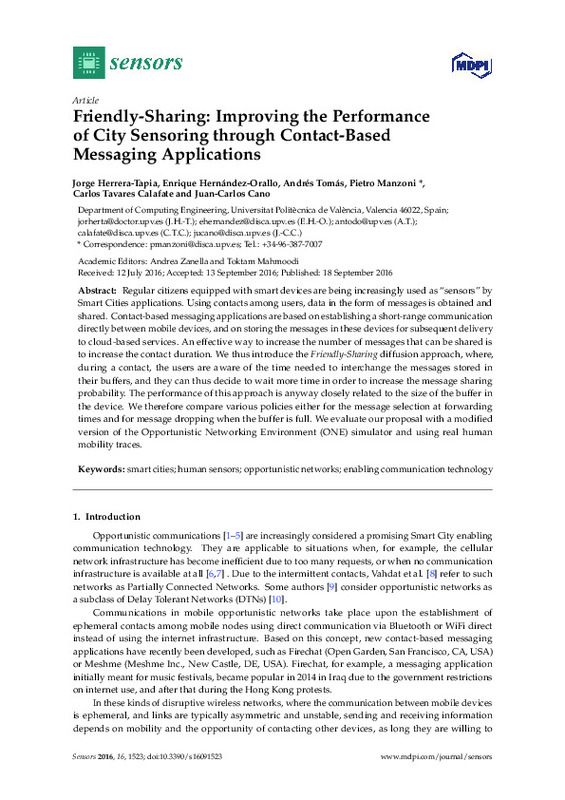JavaScript is disabled for your browser. Some features of this site may not work without it.
Buscar en RiuNet
Listar
Mi cuenta
Estadísticas
Ayuda RiuNet
Admin. UPV
Friendly-Sharing: Improving the Performance of City Sensoring through Contact-Based Messaging Applications
Mostrar el registro sencillo del ítem
Ficheros en el ítem
| dc.contributor.author | HERRERA-TAPIA, JORGE
|
es_ES |
| dc.contributor.author | Manzoni, Pietro
|
es_ES |
| dc.contributor.author | Hernández Orallo, Enrique
|
es_ES |
| dc.contributor.author | Tomás Domínguez, Andrés Enrique
|
es_ES |
| dc.contributor.author | Tavares de Araujo Cesariny Calafate, Carlos Miguel
|
es_ES |
| dc.contributor.author | Cano Escribá, Juan Carlos
|
es_ES |
| dc.date.accessioned | 2017-03-06T12:53:35Z | |
| dc.date.available | 2017-03-06T12:53:35Z | |
| dc.date.issued | 2016 | |
| dc.identifier.issn | 1424-8220 | |
| dc.identifier.uri | http://hdl.handle.net/10251/78523 | |
| dc.description | c 2016 by the authors; licensee MDPI, Basel, Switzerland. This article is an open access article distributed under the terms and conditions of the Creative Commons Attribution (CC-BY) license (http://creativecommons.org/licenses/by/4.0/). | es_ES |
| dc.description.abstract | [EN] Regular citizens equipped with smart devices are being increasingly used as sensors by Smart Cities applications. Using contacts among users, data in the form of messages is obtained and shared. Contact-based messaging applications are based on establishing a short-range communication directly between mobile devices, and on storing the messages in these devices for subsequent delivery to cloud-based services. An effective way to increase the number of messages that can be shared is to increase the contact duration. We thus introduce the Friendly-Sharing diffusion approach, where, during a contact, the users are aware of the time needed to interchange the messages stored in their buffers, and they can thus decide to wait more time in order to increase the message sharing probability. The performance of this approach is anyway closely related to the size of the buffer in the device. We therefore compare various policies either for the message selection at forwarding times and for message dropping when the buffer is full. We evaluate our proposal with a modified version of the Opportunistic Networking Environment (ONE) simulator and using real human mobility traces. | es_ES |
| dc.description.sponsorship | This work was partially supported by the Ministerio de Economia y Competitividad, Programa Estatal de Investigacion, Desarrollo e Innovacion Orientada a los Retos de la Sociedad, Proyectos I+D+I 2014, Spain, under Grant TEC2014-52690-R, the Generalitat Valenciana, Spain, under Grant AICO/2015/108, the Universidad Laica Eloy Alfaro de Manabi, Ecuador, and SENESCYT, Ecuador. | en_EN |
| dc.language | Inglés | es_ES |
| dc.publisher | MDPI | es_ES |
| dc.relation.ispartof | Sensors | es_ES |
| dc.rights | Reconocimiento (by) | es_ES |
| dc.subject | Smart cities | es_ES |
| dc.subject | Human sensors | es_ES |
| dc.subject | Opportunistic networks | es_ES |
| dc.subject | Enabling communication technology | es_ES |
| dc.subject.classification | ARQUITECTURA Y TECNOLOGIA DE COMPUTADORES | es_ES |
| dc.subject.classification | LENGUAJES Y SISTEMAS INFORMATICOS | es_ES |
| dc.title | Friendly-Sharing: Improving the Performance of City Sensoring through Contact-Based Messaging Applications | es_ES |
| dc.type | Artículo | es_ES |
| dc.identifier.doi | 10.3390/s16091523 | |
| dc.relation.projectID | info:eu-repo/grantAgreement/MINECO//TEC2014-52690-R/ES/INTEGRACION DEL SMARTPHONE Y EL VEHICULO PARA CONECTAR CONDUCTORES, SENSORES Y ENTORNO A TRAVES DE UNA ARQUITECTURA DE SERVICIOS FUNCIONALES/ | es_ES |
| dc.relation.projectID | info:eu-repo/grantAgreement/GVA//AICO%2F2015%2F108/ | es_ES |
| dc.rights.accessRights | Abierto | es_ES |
| dc.contributor.affiliation | Universitat Politècnica de València. Escola Tècnica Superior d'Enginyeria Informàtica | es_ES |
| dc.contributor.affiliation | Universitat Politècnica de València. Escuela Politécnica Superior de Gandia - Escola Politècnica Superior de Gandia | es_ES |
| dc.description.bibliographicCitation | Herrera-Tapia, J.; Manzoni, P.; Hernández Orallo, E.; Tomás Domínguez, AE.; Tavares De Araujo Cesariny Calafate, CM.; Cano Escribá, JC. (2016). Friendly-Sharing: Improving the Performance of City Sensoring through Contact-Based Messaging Applications. Sensors. 16(9):1-17. https://doi.org/10.3390/s16091523 | es_ES |
| dc.description.accrualMethod | S | es_ES |
| dc.relation.publisherversion | http://dx.doi.org/10.3390/s16091523 | es_ES |
| dc.description.upvformatpinicio | 1 | es_ES |
| dc.description.upvformatpfin | 17 | es_ES |
| dc.type.version | info:eu-repo/semantics/publishedVersion | es_ES |
| dc.description.volume | 16 | es_ES |
| dc.description.issue | 9 | es_ES |
| dc.relation.senia | 317138 | es_ES |
| dc.identifier.pmid | 27649209 | en_EN |
| dc.identifier.pmcid | PMC5038796 | en_EN |
| dc.contributor.funder | Ministerio de Economía y Competitividad | |
| dc.contributor.funder | Generalitat Valenciana |








